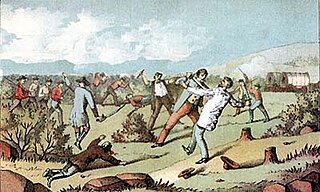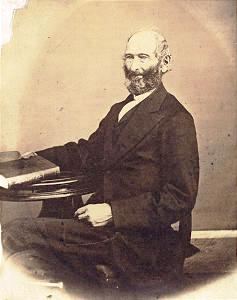
Mormons are a religious and cultural group related to Mormonism, the principal branch of the Latter Day Saint movement started by Joseph Smith in upstate New York during the 1820s. After Smith's death in 1844, the movement split into several groups following different leaders; the majority followed Brigham Young, while smaller groups followed Joseph Smith III, Sidney Rigdon, and James Strang. Most of these smaller groups eventually merged into the Community of Christ, and the term Mormon typically refers to members of the Church of Jesus Christ of Latter-day Saints, as today, this branch is far larger than all the others combined. People who identify as Mormons may also be independently religious, secular, and non-practicing or belong to other denominations. Since 2018, the LDS Church has emphasized a desire for its members be referred to as "members of The Church of Jesus Christ of Latter-day Saints", or more simply as "Latter-day Saints".
In the early Latter Day Saint movement, the School of the Prophets was a select group of early leaders who began meeting on January 23, 1833 in Kirtland, Ohio under the direction of Joseph Smith for both theological and secular learning.

The Latter Day Saint movement is a religious movement within Christianity that arose during the Second Great Awakening in the early 19th century and that led to the set of doctrines, practices, and cultures called Mormonism, and to the existence of numerous Latter Day Saint churches. Its history is characterized by intense controversy and persecution in reaction to some of the movement's doctrines and practices and their relationship to mainstream Christianity. The purpose of this article is to give an overview of the different groups, beliefs, and denominations that began with the influence of Joseph Smith.

The 1838 Mormon War, also known as the Missouri Mormon War, was a conflict between Mormons and non-Mormons in Missouri from August to November 1838, the first of the three "Mormon Wars".

David Whitmer was a leader in the Church of Jesus Christ of Latter Day Saints who eventually became the most interviewed of the Three Witnesses to the Book of Mormon's golden plates.

Lyman Wight was an early leader in the Latter Day Saint movement. He was the leader of the Latter Day Saints in Daviess County, Missouri, in 1838. In 1841, he was ordained a member of the Quorum of the Twelve Apostles. After the death of Joseph Smith resulted in a succession crisis, Wight led his own break-off group of Latter Day Saints to Texas, where they created a settlement. While in Texas, Wight broke with the main body of the group led by Brigham Young. Wight was ordained president of his own church, but he later sided with the claims of William Smith, and eventually of Joseph Smith III. After his death, most of the "Wightites" joined with the Reorganized Church of Jesus Christ of Latter Day Saints.

Far West was a settlement of the Latter Day Saint movement in Caldwell County, Missouri, United States, during the late 1830s. It is recognized as a historic site by the U.S. National Register of Historic Places, added to the register in 1970. It is owned and maintained by the Church of Jesus Christ of Latter-day Saints.

John Whitmer was an early leader in the Latter Day Saint movement. He was one of the Eight Witnesses of the Book of Mormon's golden plates. Whitmer was also the first official Church Historian and a member of the presidency of the church in Missouri from 1834 to 1838.
Hiram Page was an early member of the Latter Day Saint movement and one of the Eight Witnesses to the Book of Mormon's golden plates.
Warren Farr Parrish was a leader in the early Latter Day Saint movement. Parrish held a number of positions of responsibility, including that of scribe to church president Joseph Smith. Parrish and other church leaders became disillusioned with Smith after the failure of the Kirtland Safety Society and left the Church of Jesus Christ of Latter Day Saints in 1837. In 1838, they formed a short-lived church in Kirtland, Ohio which they called The Church of Christ, after the original name of the church organized by Smith. This church soon disintegrated as the result of disagreement between its leaders. By 1844, Parrish was working as a Baptist minister in the Fox River area of Wisconsin & Illinois.
Within the Latter Day Saint movement, Zion is often used to connote an association of the righteous. This association would practice a form of communitarian economics, called the United Order, which were meant to ensure that all members maintained an acceptable quality of life, class distinctions were minimized, and group unity achieved.
John Corrill was an early member and leader of the Church of Jesus Christ of Latter Day Saints, and an elected representative in the Missouri State Legislature. He was prominently involved in the Mormon conflicts in Missouri before leaving the church in 1839 and publishing A Brief History of the Church of Christ of Latter Day Saints .

The life of Joseph Smith from 1838 to 1839, when he was 33–34 years old, covers a period beginning when Smith left Ohio in January 1838 until he left Missouri and moved to Nauvoo, Illinois in 1839.

The Temple Lot, located in Independence, Missouri, is the first site to be dedicated for the construction of a temple in the Latter Day Saint movement. The area was dedicated on August 3, 1831, by the movement's founder, Joseph Smith. It was purchased on December 19, 1831, by Edward Partridge to be the center of the New Jerusalem or "City of Zion" after Smith said he received a revelation stating that it would be the gathering spot of the Latter Day Saints during the last days.

Joseph Smith Jr. was an American religious leader and the founder of Mormonism and the Latter Day Saint movement. Publishing the Book of Mormon at the age of 24, Smith attracted tens of thousands of followers by the time of his death fourteen years later. The religion he founded is followed to the present day by millions of global adherents and several churches, the largest of which is the Church of Jesus Christ of Latter-day Saints.
Algernon Sidney Gilbert was a merchant best known for his involvement with Latter-day Saint history and his partnership with Newel K. Whitney in Kirtland, Ohio. He is mentioned in seven sections of The Church of Jesus Christ of Latter-day Saints Doctrine and Covenants. He was ordained as a high priest in the state of Missouri and served as a missionary in the United States.
John Sims Carter was an American leader in the early Latter Day Saint movement. In the Church of the Latter Day Saints based in Kirtland, Ohio, Carter was one of 12 members of the first presiding high council established in 1834 by church founder Joseph Smith.

The life of Joseph Smith, Jr. from 1831 to 1837, when he was 26–32 years old, covers the period of time from when Smith moved with his family to Kirtland, Ohio, in 1831, until he left Ohio for Missouri early in early January 1838. By 1831, Smith had already published the Book of Mormon, and established the Latter Day Saint movement. He had founded it as the Church of Christ, but eventually dictated a revelation to change its name to the Church of Jesus Christ of Latter Day Saints.

The Expulsion of Mormons from Jackson County, Missouri in 1833 resulted in the forced removal of Latter Day Saints from Jackson County, Missouri. The expulsion occurred amidst escalating violence between Mormon residents and non-Mormon vigilantes.












